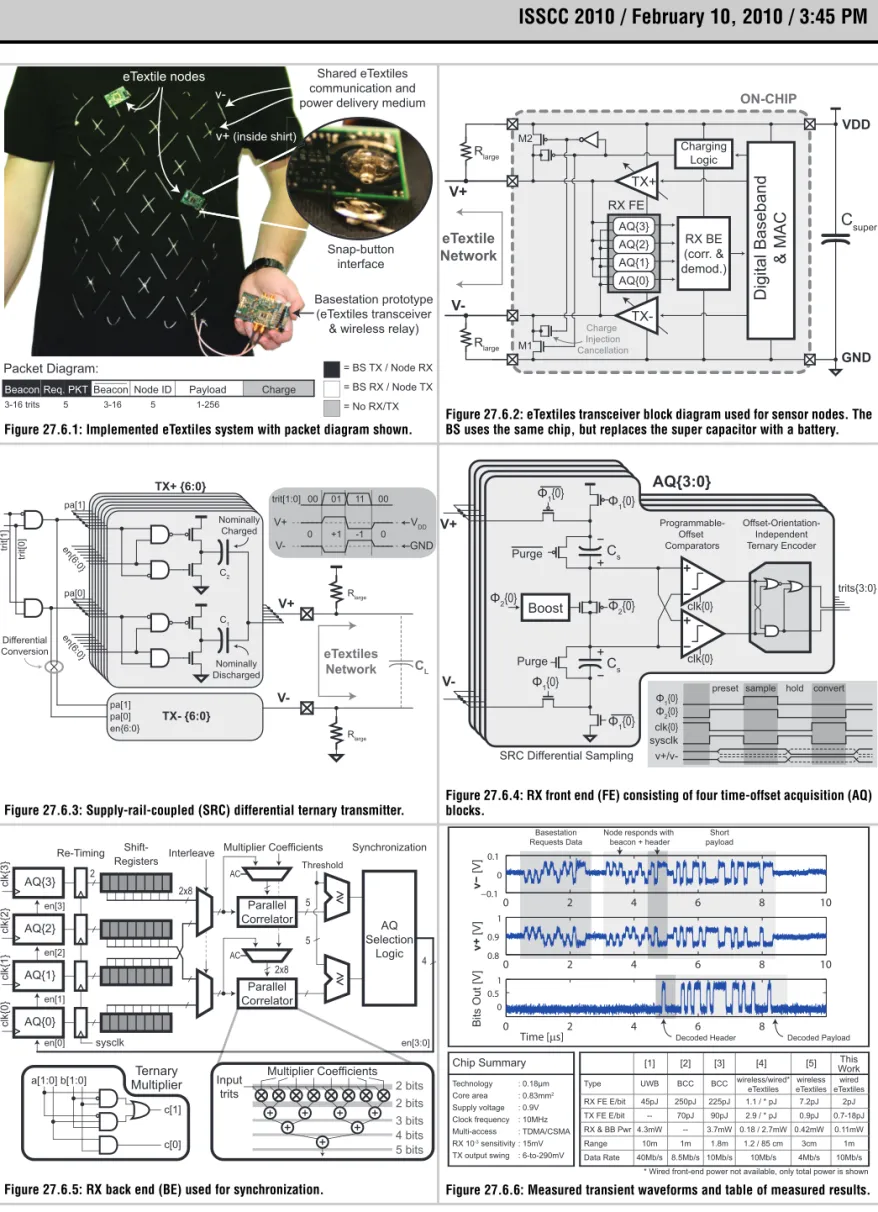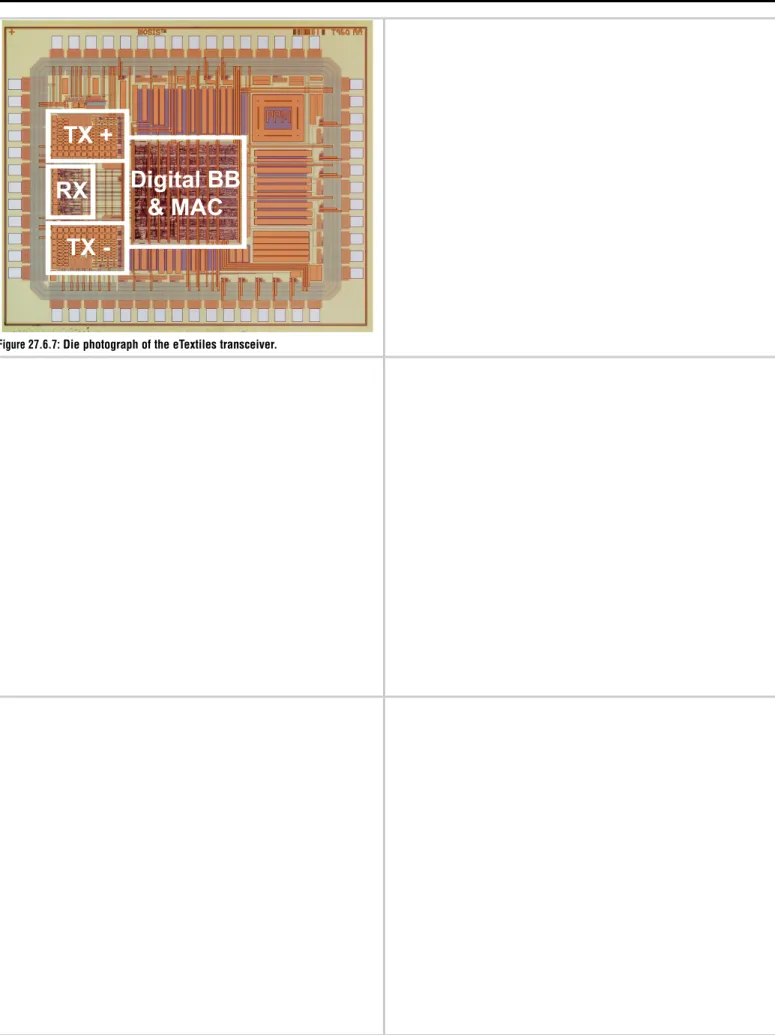A 110μW 10Mb/s eTextiles transceiver for
body area networks with remote battery power
The MIT Faculty has made this article openly available.
Please share
how this access benefits you. Your story matters.
Citation
Mercier, P.P., and A.P. Chandrakasan. “A 110µW 10Mb/s Etextiles
Transceiver for Body Area Networks with Remote Battery Power.”
Solid-State Circuits Conference Digest of Technical Papers (ISSCC),
2010 IEEE International. 2010. 496-497. Copyright © 2010, IEEE
As Published
http://dx.doi.org/10.1109/ISSCC.2010.5433868
Publisher
Institute of Electrical and Electronics Engineers
Version
Final published version
Citable link
http://hdl.handle.net/1721.1/62195
Terms of Use
Article is made available in accordance with the publisher's
policy and may be subject to US copyright law. Please refer to the
publisher's site for terms of use.
496
• 2010 IEEE International Solid-State Circuits Conference
ISSCC 2010 / SESSION 27 / DIRECTIONS IN HEALTH, ENERGY & RF / 27.6
27.6
A 110µW 10Mb/s eTextiles Transceiver for Body
Area Networks with Remote Battery Power
Patrick P. Mercier, Anantha P. Chandrakasan
Massachusetts Institute of Technology, Cambridge, MA
Emerging sensor technologies are enabling low-cost ambulatory medical devices for remote patient monitoring. In order to replace traditional bulky wired links used to communicate data around and away from the body, recent work has proposed the use of wireless body area networks (BANs) and body-coupled communication (BCC) systems [1-3]. Although such links typically communi-cate over short distances, the human body presents significant path loss, requir-ing high TX output power or large RX amplification. Additionally, these inherent-ly single-ended systems must tolerate significant interference from external sources and nearby users.
An emerging technique for conveying information around the human body uses electronics textiles (eTextiles) as a communication medium [4-5]. Figure 27.6.1 shows the implemented eTextiles system, where the medium consists of two electrically separate grids of conductive yarn. Sensor nodes physically connect to the shared medium using metallic button-snaps, and communicate via an eTextiles transceiver chip. Using a pair of physical low-impedance connections has the distinct advantage over wireless and/or BCC systems to be able to: 1) signal differentially, permitting energy-efficient amplitude-modulation schemes that tolerate coupled interference, and 2) power sensor nodes remotely from a local basestation (BS) at extremely high efficiency, minimizing the energy stor-age requirements on each node. In the proposed system, each sensor node is pre-programmed with a unique 5b ID code, enabling the BS to administer medi-um access using a TDMA scheme. New nodes added to the eTextiles network are dynamically recognized and added to the BS queue. Additionally, energy-expen-sive multi-user access and encryption operations can be delegated to the BS since the wired communication link is inherently secure.
A block diagram of the proposed eTextiles transceiver SoC, used in both sensor nodes and the BS, is shown in Fig. 27.6.2. The two main inputs, v+ and v-, feed the RX front end (FE), and are the outputs of differential transmitters. Between packets, a fixed amount of time is allocated to activating transistors M1 and M2 on all sensor nodes and the BS, directly connecting v+ and v- to the supply ter-minals of each chip. This permits the BS battery to remotely charge each node’s external super capacitor, which functions as each node’s energy supply. Time-sharing of the eTextiles medium with remote charging circuitry forces the DC voltages on v+ and v- to be at opposite rails at the beginning of packet com-munication. To save the energy otherwise required to completely charge and dis-charge the primarily capacitive medium, the DC voltages are held constant by high impedance resistors, and transmitted signals are AC coupled onto the medium with supply-rail-coupled (SRC) differential transmitters (Fig. 27.6.3). This approach is advantageous, as capacitive-driving reduces output voltage swing and driver load [6,7], irrespective of the network DC potential. Additionally, by using dual capacitors C1and C2 that are nominally discharged
and charged, respectively, a ternary signaling scheme can be used, simplifying RX synchronization algorithms. To illustrate, asserting pa[0] in TX+ charges C1,
producing a negative voltage swing on the output that is proportional to the capacitive divider ratio of C1and CL. Asserting pa[1] would instead discharge C2,
generating a positive voltage swing. The opposite effects are arranged for TX-, making the signaling scheme differential, yet operating at different DC levels. Both TX+ and TX- consist of 7 pairs of binary-weighted tri-state inverters and capacitive DACs to provide voltage swing configurability.
The RX FE samples and digitizes the SRC differential voltage across v+ and v-using 4 time-offset acquisition (AQ) blocks (Fig. 27.6.4). An SRC common-mode independent sampling structure is implemented, exploiting the fact that v+ and
v- have DC potentials centered at opposite rails. Before packet reception, the
sampling capacitors are purged. During the preset phase, the capacitors are charged to the supply rails; since the top plates are floating, their potentials set-tle to mid-rail. During sampling, the bottom capacitor plates are connected to the eTextiles network. As the inputs are already centered at opposite DC potentials and the top plates remain floating, only differential charge is sampled on top of the existing mid-rail charge residing on each capacitor. As a result, during the
hold phase, the inputs to the comparators are differentially centered at mid-rail, requiring no additional biasing and reducing the CMRR requirements of the ensuing comparators.
Samples are converted to ternary digits (trits) by two clocked comparators sized for a 3σ offset under 25mV. Each comparator has 8 bits of differential pair and current source weighting, providing offsets that vary by ±60mV. The compara-tors are configured to have equal and opposite non-zero offsets, such that any differential samples above or below the absolute offset level convert to trits ‘+1’ or ‘-1’, respectively; samples residing between the offset levels convert to ‘0’. The conversion is performed by an offset orientation-independent ternary encoder, permitting the comparator pair to swap roles. After calibration, this form of comparator configuration-redundancy improves the σ of offset errors, measured as the difference between the desired and attained offset for each comparator, by 1.5-2.5X.
Each sample and conversion operation completes in two clock cycles, requiring two interleaved AQ blocks to demodulate data at full rate. Synchronization is achieved in the RX back end (BE) by correlating incoming data using two addi-tional AQ blocks to ensure sampling occurs every half clock period (Fig. 27.6.5). A custom multiplier is implemented for the correlator ternary arithmetic, saving 2 bits in each adder stage over a traditional 2’s complement topology. If a cor-relator output crosses a programmable threshold, synchronization is achieved, and the two unused AQ blocks are clock gated. Alternatively, the RX BE can be configured in an auto-correlation mode for a CSMA MAC.
The transceiver is fabricated in 0.18µm CMOS, occupies a core area of 0.83mm2,
and operates at 0.9V. Although healthcare applications typically only require 10-100kb/s per sensor, the transceiver communicates at a raw data rate of 10Mb/s to accommodate up to 30 time-multiplexed sensor nodes on the shared medi-um and to provide margin for remote charging duty-cycling and coding over-head. The RX FE consumes 2pJ/bit, which is at least 20X lower than wireless and BCC systems operating at similar distances, and is comparable to wireless eTextiles systems operating over much shorter distances (Fig. 27.6.6). Over 1m, the TX FE consumes 0.7-to-18pJ/bit for output voltage swings from 6-to-290mV. At 100% receive-mode duty cycle, the chip consumes 110µW, including RX, digital baseband, and I/O power. The remote battery scheme achieves 95% power transfer efficiency from BS to sensor node, compared to 54.9% for wire-less power transfer efficiency [8]. Figure 27.6.6 shows measured transmitted and received waveforms, and summarizes the chip results. A die photo is shown in Fig. 27.6.7.
Acknowledgements:
This work was funded in part by the FCRP Focus Center for Circuit & System Solutions (C2S2), under contract 2003-CT-888.
References:
[1] M. Verhelst et al., “A reconfigurable, 0.13µm CMOS 110pJ/pulse, fully inte-grated IR-UWB receiver for communication and sub-cm ranging,” ISSCC Dig. Tech. Papers, pp. 250-251, Feb. 2009.
[2] A. Fazzi et al., “A 2.75mW wideband correlation-based transceiver for body-coupled communication,” ISSCC Dig. Tech. Papers, pp. 204-205, Feb. 2009. [3] N. Cho et al., “A 60kb/s-to-10Mb/s 0.37nJ/b Adaptive-Frequency-Hopping Transceiver for Body-Area Network,” ISSCC Dig. Tech. Papers, pp. 132-133, Feb. 2008.
[4] J. Yoo et al., “A 1.12pJ/b resonance compensated inductive transceiver with a fault-tolerant network controller for wearable body sensor networks,” Proc. A-SSCC Tech. Papers, pp. 313-316, Nov. 2008.
[5] S. Lee et al., “A Dynamic Real-time Capacitor Compensated Inductive Coupling Transceiver for Wearable Body Sensor Network,” Proc. Symp. VLSI Circuits, pp. 42-43, Jun. 2009.
[6] R. Ho et al., “High-Speed and Low-Energy Capacitively-Driven On-Chip Wires,” ISSCC Dig. Tech. Papers, pp. 412-413, Feb. 2007.
[7] P. Mercier et al., “An Energy-Efficient All-Digital UWB Transmitter Employing Dual Capacitively-Coupled Pulse-Shaping Drivers,” IEEE J. Solid-State Circuits, vol. 44, no. 6, pp. 1679-1688, Jun. 2009.
[8] J. Yoo et al., “A 5.2mW Self-Configured Wearable Body Sensor Network Controller and a 12µW 54.9% Efficiency Wirelessly Powered Sensor for Continuous Health Monitoring System,” ISSCC Dig. Tech. Papers, pp. 290-291, Feb. 2009.
497
DIGEST OF TECHNICAL PAPERS •
ISSCC 2010 / February 10, 2010 / 3:45 PM
Figure 27.6.1: Implemented eTextiles system with packet diagram shown.
Figure 27.6.2: eTextiles transceiver block diagram used for sensor nodes. The BS uses the same chip, but replaces the super capacitor with a battery.
Figure 27.6.3: Supply-rail-coupled (SRC) differential ternary transmitter.
Figure 27.6.5: RX back end (BE) used for synchronization. Figure 27.6.6: Measured transient waveforms and table of measured results. Figure 27.6.4: RX front end (FE) consisting of four time-offset acquisition (AQ) blocks.
Shared eTextiles communication and power delivery medium
Basestation prototype (eTextiles transceiver
& wireless relay)
v+ (inside shirt) v-Beacon Packet Diagram: Snap-button interface 3-16 trits 5 3-16 5 1-256 Beacon Req. PKT Node ID = BS TX / Node RX = BS RX / Node TX = No RX/TX Payload Charge eTextile nodes eTextile Network TX+ RX FE GND VDD V+ V-ON-CHIP
TX-Digital Baseband
& MAC
C
super Rlarge Rlarge Charge Injection Cancellation M1 M2 AQ{3} AQ{2} AQ{1} AQ{0} Charging Logic RX BE (corr. & demod.) en{6:0} en{6:0} en{6:0} pa[0] Differential Conversion Nominally Charged C2 C1 Rlarge Nominally Discharged trit[1] trit[1:0] 01 +1 00-1 11 00 00 trit[0] pa[1] pa[0] pa[1] TX+ {6:0} TX- {6:0} V+ V+ VDD GND V-Rlarge V-eTextiles Network CL trits{3:0} V+ V-Boost Programmable-Offset Comparators SRC Differential Sampling Offset-Orientation-Independent Ternary EncoderAQ{3:0}
Φ1{0} Φ1{0} Φ1{0} Φ1{0} Φ2{0} Φ2{0} Φ2{0} samplepreset hold convert
clk{0} clk{0} clk{0} Cs Cs Purge Purge Φ1{0} sysclk v+/v-AQ{3} Re-Timing Shift-Registers Interleave Multiplier Coefficients Threshold AC Parallel Correlator Ternary Multiplier 2 AQ{2} AQ{1} AQ{0} en[3] clk{3} clk{2} clk{1} clk{0} en[3:0] en[2] en[1] en[0] sysclk a[1:0] b[1:0] c[0] c[1] 2x8 5 5 4 2x8 AQ Selection Logic Synchronization Parallel Correlator Input trits Multiplier Coefficients 2 bits 2 bits 3 bits 4 bits 5 bits AC
Chip Summary This
Work Type Data Rate RX FE E/bit TX FE E/bit RX & BB Pwr Range Technology
Decoded Header Decoded Payload
[1]
UWB BCC BCC wireless/wired* eTextiles
* Wired front-end power not available, only total power is shown wireless eTextiles wired eTextiles 45pJ 4.3mW 3.7mW 250pJ 1.1 / * pJ 7.2pJ 2pJ 0.7-18pJ 0.9pJ 0.42mW 2.9 / * pJ 0.18 / 2.7mW 225pJ 90pJ 10Mb/s 10Mb/s 4Mb/s 10Mb/s 70pJ --8.5Mb/s --10m 1m 1.8m 1.2 / 85 cm 3cm 1m 0.11mW 40Mb/s [2] [3] [4] [5] : 0.18μm : 0.83mm2 : 0.9V : 10MHz : 15mV : 6-to-290mV : TDMA/CSMA Supply voltage Clock frequency RX 10-3 sensitivity TX output swing Multi-access Core area Basestation Requests Data
Node responds with beacon + header Short payload 0 2 4 6 8 10 −0.1 0 0.1 v− [V] 0 2 4 6 8 10 0.8 0.9 1 v+ [V] 0 2 4 6 8 0 0.5 1 Time [µs] Bits Out [V]
27
• 2010 IEEE International Solid-State Circuits Conference
978-1-4244-6034-2/10/$26.00 ©2010 IEEE
ISSCC 2010 PAPER CONTINUATIONS
Figure 27.6.7: Die photograph of the eTextiles transceiver.

